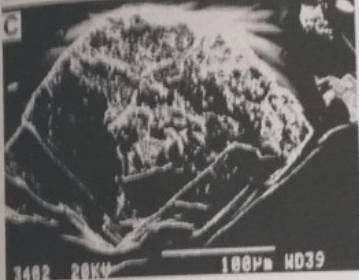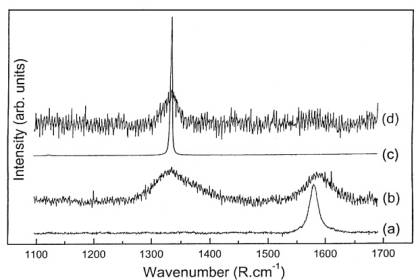|
What tell us the finds of carbon
and diamonds in the LDG, other glassy melts and breccias in the Silica-strewnfield
in the Egyptian Great Sand Sea
Norbert Brügge, Germany
Dipl.-Geol.
Upload: April 2018
Update: 26.05.2020
Diamond is a solid form
of carbon with a cubic crystal structure. Most of them were formed in
enormeus depths in the Earth's mantle. Under high pressure and temperature,
carbon-containing fluids dissolved minerals and replaced them with diamonds.
Diamonds are deposited in igneous rocks known as
kimberlites and lamproites
carried to the surface by volcanic eruptions. Extraterrestrial diamonds, mostly
of a microscopic size, are found in carbonaceous chondrites.
In the strewnfield of the Libyan Desert Glass (LDG)
is hidden not only the secret of the creation of this unique glass itself,
but also the origin of some accumulations of carbon/graphite and diamonds
/micro-diamonds embedded in glassy melts within breccias. In the meantime
it can be ruled out that these materials are of extraterrestrial origin. To
convincing are indications for a connection with the widespread volcanism
in the region. Here we have diamonds that have been transported from the earth's
mantle to the earth's surface.
The following locations are known so far, and they should not be the last.
Unfortunately, all the ludicrous interpretations of the elaborate investigations
point in the totally wrong direction, as the citations listed below from the
publications prove. The find of kimberlite (Location
3 and 8) bring the impact theory now the death.
|
|
Location
|
Position
|
Characteristics
|

|
|
1
|
Desert
Glass
|
Strewnfield
|
Carbonaceous
inclusions, polymorphs of graphite and diamond
|
|
2
|
Breccia
1 (Hypatia stone)
|
25�20"/
25�29'
|
Micro-diamonts
in a carbonaceous matrix
|
|
3
|
Breccia
2 (Qaret-el-Hanash)
|
25�04'
/ 25�55'
|
Dark
brown Diamonds in a glassy matrix of kimberlite breccia
|
|
4
|
Debris
in Paleosol
|
25�18.11'
/ 25�29'
|
Polymetallic
and carbonaceous debris
|
|
5
|
Mullite-magnetite-glass
melt rock
|
Southeast
of the Silica area
|
Dark
grey mullite-magnetite-glass melt rock with numerous diamonds
|
|
6 |
Breccia 3 |
25�17`00" / 25�36'23" |
Hill
of breccias ( + carbonaceous material)
|
|
7
|
Breccia 4 |
25�22`51" / 25�27'34" |
Megascopic
breccia ( + graphite, glass)
|
|
8 |
Crater Zerzura (Kimberlite
pipe)
|
25�16'46" / 25�10'05"
|
Diverse
components ( + micro diamonds ?)
|
|
9 |
Gilf Kebir Crater Field |
50 km east
of Gilf Kebir
|
Fist-sized chunk with diamonds;
confirmed by tester |
|
1.
Libyan Desert
Glass
Crystalline
microstructures in Libyan Desert Glass: Effect of microgravity environment
C. Patuelli, R. Serra, S. Coniglione, M. Chiarini
Microgravity and Space Station Utilization, vol. 3, no. 4, 2002
"Samples of Libyan Desert Glass were analyzed by
X-ray micro-diffraction technique. It was identified fourteen nano-sized
crystalline LDG phases with different colours: Coesite, tridymite,
stishovite, baddeleyite, huttonite, yttrium, moissanite, platinium,
polymorphs of diamond and graphite.
The four praphite polymorh phases found in LDG samples can be explained
by taking into account that the graphite came from the earlier history
of the material. The element platinum is extremely scarce in most crustal
rocks. The origin of platinum is from ultra-mafic igneous rocks. Its melting
point is 1775 �C. The zircon oxide mineral Baddeleyite is the product
of the decomposition of zircon at 1775� - 1900�C. Moissanite is a natural
silicon carbide (SiC). Huttonite is a low-temperature and low-pressure
Thorite-polymorph (ThSiO2).
The identification of nine highbaric phases, the
presence of hexagonal diamond with four phases of graphite polymorphs,
as well as huttonite and baddeleyite, confirm that LDG formed by "shock
metamorphism" at very high pressure and temperature. The nano-sized crystalline
phases revealed point out that LDG rapidly solidified.
Preliminary X-ray micro-diffractometry analyses were presented at the
�Silica 96� workshop (Patuelli, 1997). High pressure and high temperature
phases were identified: including samarium, germanium 12T, thorium beta
(this beta phase occurs only at a temperature above 1350�C) and stishovite,
which is a high temperature and pressure form of SiO2."
|
|
Investigation of inclusions
trapped inside Libyan Desert Glass by Raman microscopy
M. Swaenen, E.A. Stefaniak, R. Frost, A. Worobiec &
R. Van Grieken -- Analytical and Bioanalytical Chemistry, 397 (7), pp.2659-2665
"The inclusion in Fig. 7 was quite surprising as well. It is composed
of at least two different phases � the white one, which MRS spectrum was
only a big fluorescence hump, and the brownish one, which apparently contains
amorphous carbon. MRS spectra in Fig. 7 represent different spots within
the brown area. The two characteristic D and G band shape proves
doubtlessly that carbon was there,
but it doesn't give any explanation how organic matter could be preserved
in hot molten silica."
|
 |
|
Silicate-Silicate
liquid immiscibility and graphite ribbons in Libyan Desert Glass
G. Pratesi, C. Viti, C. Cipriani, M. Mellini
Geochimica et Cosmochimica Acta, March 2002
"Transmission electron microscopic (TEM) investigation of the dark (brown
or bluish) streaks occurring in Libyan Desert Glass reveals the common
presence of small glass spherules. The spherules, mostly 100 nm
in size, are homogeneously dispersed within the silica-glass matrix. The
complete absence of electron
diffraction effects confirms their amorphous nature. The spherules are
Al-, Fe- and Mg-enriched with respect to the surrounding silica matrix
and their (Mg+Al+Fe) : Si ratio is close to 1. The silica-glass matrix
and amorphous spherules form an emulsion texture (i.e., globules of one
glass in a matrix of another glass), which originates from silicate-silicate
liquid immiscibility.
The silica glass also contains carbonaceous inclusions
consisting of 5�50 nm thick, polygonalized graphite
ribbons that form closed structures up to 200 nm in diameter.
Graphite inclusions
Rare carbon-bearing inclusions randomly occur within the silica-glass
matrix. Their presence is ubiquitous and not limited to the regions with
dark streaks. C-bearing inclusions produce an evident C peak in the EDS
spectra. The inclusions consist of ring-shaped polygonalized ribbons,
5�50 nm thick, typically forming closed structures with an overall diameter
of ~200 nm. Their SAED patterns consist of rings with d-spacings of 3.35,
2.09 and 1.67 A: these values correspond to graphite (3.36, 2.13-2.03,
1.678 A, JCPDS 23-64). Lattice imaging shows 3.35 A polygonized (002)
lattice fringes. The fringes are quite regular, thus indicating good structural
order with no evidence of deformation or defects. Dark vertical bands
are evident at the polygonal edges and are interpreted as Moire textures."
|
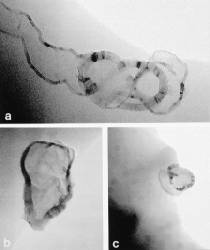
Graphite polymorphs
|
2.
Hypatia
stone
Probably debris of
Kimberlite
First paper by Aly Barakat, the discoverer of
the stone
5.3-THE MINERALOGICAL COMPOSITION:
The mineralogical composition includes; diamond,
graphite, goethite, quartz calcite and halite.
5.3.1-Diamond: Diamond aggregations occur as tiny angular grains (fragments)
showing the characteristic lustre and cleavage. Some of these grains show
indications of octahedral form), but others are suggestive of partial hexagonal
form. EDAX analysis (Fig. 5.3) of some grains indicates that they consist
essentially of C (~98 %).
The XRD analysis data are consistent with the presence of diamond of interplanar
distances (d) 2.07, 1.259, and 1.881 (JCPDS, card 6-675) as indicated by the
Camera method. Moreover, diamond appears through the chart of the other X-ray
diffraction method.
Raman spectrometric analysis of the bright aggregates confirms the presence
of diamond in a polycrystalline status, as witnessed by the significantly
broad peak at 1331 cm-1, spectra b and d). In spectrum (b), diamond is associated
with graphite (peak in the 1580 cm-1 region). In spectrum (d), the broad band
at 1332 cm-1 is a good evidence for the presence of diamond in the form of
microcrystalline aggregates (note the sharp peak of the well crystalline diamond
on the reference spectrum c). Thus, the observed large grains represent quite
large aggregates of micrometer-sized crystallites.
5.3.2-Graphite: Graphite occurs as thin laminated encrustation coating and
embedding the diamond aggregations. The Raman spectroscopy confirms also the
intimate association between graphite and diamond (Fig. 5.5, spectrum b).
Graphite is also present in the form of microcrystalline grains. In figure
(5.5, spectrum a) the single peak at 1580 cm-1 is of crystalline graphite
(mean basal plane >>1000 �). This phase is also known as the G mode. Progressive
disorder in graphite is reflected in the Raman spectrum by the broadening
and shifting of this band to higher wave numbers, and by development of an
additional band near 1360 cm-1 (also known as the D mode) (Pasteris and Wopenka,
1991; Hirlimann, et al., 1992). The peak around 1360 cm-1 in spectrum b (Fig.
5.5) is aconvolution of two peaks. This is due to the presence of both diamond
and graphite in intimate association.
3. Qaret-el-Hanash
The first detected
Kimberlite pipe nearby the Silica strewnfield
The most important indication for the emergence of Qaret-el-Hanash,
which I postulate now as a kimberlite pipe, are the photos of Ursula Steiner
(Switzerland), which come from the top and southwestern outside slope of the
structure and are available to me. The photos document clear the volcanic
origin of Qaret-el-Hanash impressively. Some photos from the debris outside
show a strange material of a dark (carbonaceous ?) melt with included many
diverse fragments, among ferruginous pieces, debris of basement (BIF), glass,
yellow jasper and minerals.
The melt contain also large dark brown pieces, which
could be diamonds. So far this could not be checked. The whole
composition is chaotic.
|

This piece from the
breccia contain probably large dark brown diamonds
Photographed during
a trekking-tour in 2012
|
DISCOVERY OF Fe-Cr-Ni SPECKS WITHIN QARET
EL-HANASH BRECCIA OF THE LIBYAN GLASS AREA SOUTH WESTERN EGYPT
A. El-Kammar, I. Arafa, K. A. Soliman & A. Barakat --7th International
Conference on the Geology of the Arab World, Cairo University, Feb. 2004,
P. 1-7
"The rock consists of various fragments of local sandstone,
i.e., from the area of the glass distribution itself. Fragments of igneous
source have never been recorded. The rock fragments range from fraction
of mm up to 4-cm in diameter, in the collected specimens. The rock fragments
vary in colour from creamy white to brownish-red. They are angular to
subrounded and embedded in a dull greyish-black matrix. The microscopic
investigation and scanning electron microanalysis confirmed the above-mentioned
observation and showed that the matrix consists of shattered and fragmented
quartz grains of various sizes. In addition to quartz, the matrix contains
many other phases, such as glass, zircon, clay minerals, wollastonite,
ilmenite, Mg-ilmenite, rutile and Fe-Cr-Ni specks.
There are several metallic specks of various sizes ranging from 1 micron
up to about 10 micron, dispersed in the matrix of Qaret el Hanash breccia.
They invade some of the quartz grains. These specks are mainly of irregular
outlines and some of them show clear fissures. They are associated with
glass and intercalated in some cases with halite. EDAX analyses of such
specks indicate that they consist of native Fe, Cr and Ni, in addition
to subordinate Si and Ca. Finer particles of similar appearance have also
been noticed by the petrographical microscope through the fractures of
some of the quartz grains.
The most interesting achievement of the chemical analyses is the detection
of high Ir content (2.0-2.2 ppb) within the breccias. This value represents
the highest reported values for the area. The reported value of Ir in
other breccias in the area is around 1.6-1.9 ppb. The highest reported
concentration of Ir by the previous studies was detected from the black
streak portions from the Libyan glass itself is 1.25 ppb."
Personal information by Aly Barakat on May 19, 2018: The samples
contains tiny particles of Fe-Cr-Ni, and other phases includes tiny grains
of moissanite and diamond.
|
4. Debris in Paleosol
Polymetallic and carbonaceous debris in paleosol from the
Libyan Desert Glass strewn field, SW Egypt: Evidence of a cometary impact.
M. A. G. Andreoli, & M. Di Martino et al. -- Lunar and Planetary
Science XLVIII (2017),
1045.pdf
An expedition in November 2011 to the find area of "Hypatia"
failed to recover additional hand specimens of "Hypatia" material, but
samples of pedogenic pebbly deposits. One of these samples (WZER-8) was
collected 3.5 km south of the Hypatia sampling site in the dune (25�18.11'
/ 25�29').
After fractional separations of the sample was identified evidence of
hard amorphous carbon and submicron diamonds
as well as unusual metallic mineral grains, all those found in the "Hypatia"
stone.
The unusual metallic grains and carbonaceous particles tentatively grouped
into 4 types:
Type I grains and spherules range from 10-20 μm up to 130 μm. SEM-EDX
data indicate that the smaller spherules are metallic with a wide compositional
range comprising Ti, Ag, Al, and Si in varying porportions, and Ca, O,
Na, Mg and S as variable, minor constituents. The largest spherules are
pale green and vitreous and consist entirely of P, Si with no detectable
oxygen.
Type II grains are much larger (length: 60 μm to 1.2 mm) and consist
of
a) sintered aggregates of Pb metal particles
b) strongly sintered clusters of α-Ti (+1.0 at.% Al) subgrains
c) more brittle aggregates of seemingly submicron, Sn-Ca alloy particles.
The Ti metal grains in places host clusters of quenched gas bubbles, blobs
of Ti aluminide, veinlets of non-stoichiometric Ti nitride, Al oxycarbonitride,
and particles of Zr, Ag, and Zn. A distinctive feature of the Type II
grains is their localized coating by (C, O bearing) carbonaceous films
and filaments up to 300 μm in length. Although these resemble fungal hyphae
and tendrils in SEM images, Raman spectra prove that they comprise partly
graphitized kerogen.
Type III grains are shard-like in shape and occur either as partly
oxidized branching (70 μm x 50 μm) Al particles decorated by μm-size Bi
granules, or as lace-textured Ti particles partly enveloped by Type II
grains. Petrographic textural analysis of multiple 3-D sections of the
shard indicate that the Type II (and perhaps Type I) grains were derived
from the partial to complete melting of the Type III shards.
|

Location WZER-8
|
|
Type IV
grains are morphologically and compositionally diverse, with common characteristics
being Carbon as the major constituent. Moissanite (SiC) grains were the
first to be positively identified from petrography and Raman spectra.
Other grains display a range of textures, including one resembling a honeycomb
with N as second major constituent and minor, varying amounts of S and
Cl. The Raman spectra of these N-rich grains show faint, indistinct D
and G bands but distinctive peaks in the 3000 cm-1 region, indicative
of C:H bonds. |
5. Mullite-magnetite-glass melt rock
About the Occurrence of micron-sized diamonds in the mullite-magnetite-silica
glass boulders in the Gilf Kebir area of western Egypt
Marco Andreoli -- School of Geosciences, University
of the Witwatersrand, South Africa; Unpublished document (2017)
|

|
In 2017
numerous micron-sized diamonds, along with
disordered graphite, were discovered in a light sandy-grey section of
a fragment of the mullite-magnetite rock, but absent from the dark glassy
areas on the same specimen.
Left: three fragments from a single pebble, two
of which have been sawn. The piece on the bottom was polished for Raman
spectroscopy during which microdiamonds were found in the sandy-grey sections.
The dark, more highly polished, area is a mullite-magnetite-glass assemblage
lacking diamonds (Erasmus et al. 2017). The rusty coloured surface-staining
is natural.
Right: wind-sculpted piece similar to that which was studied by Ferri�re
et al. (2009). |
|

|
"From available evidence (Raman
spectrum) diamonds and disordered graphite are likely to be found in the
majority of the dark patches present in the photomicrographs" |
Note: Mullite is formed in magmatic rocks as a decomposition product
of sillimanite (sillimanite → mullite + SiO2). Sillimanite is a nesosilicate
from the group of aluminosilicates and is considered as a indicator for the
thermodynamic transformations of andalusite and kyanite in rocks of the amphibolite
and granulite facies.
6. Hill of Breccias
METEORITE IMPACT EFFECTS IN THE LIBYAN GLASS
AREA, SOUTHWESTERN EGYPT
By Aly Abd Alla Barakat, -- Cairo University, 2004
Aly Barakat found this
hill structure at 25�17'00"N / 25�36'23"E and noted:
"The basal sandstone rock intrudes the overlaying
sequences and protrudes as hillocks of about 30 m above the surrounding
desert level.
Tracing carbonaceous material within
this breccia is of considerable interest. In addition, X-ray diffraction
analysis of sample from this breccia shows the presence of ambiguous and
unexpected material, such as native aluminum and ringwoodite. These
ambiguous minerals were not expected to find in this breccia."
|
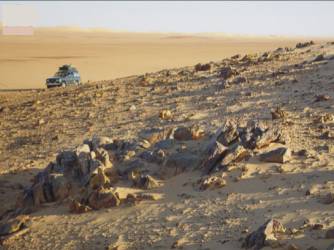
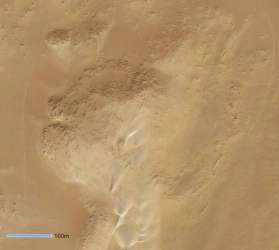
|
|
7. Megascopic ferruginous
Breccia
METEORITE IMPACT EFFECTS IN THE LIBYAN GLASS AREA,
SOUTHWESTERN EGYPT
By Aly Abd Alla Barakat, -- Cairo University, 2004
Aly Barakat found
this hill structure at 25�22'51"N / 25�27'34"E and noted:
"There is a very strange exposure of megascopic breccia
observed during the expedition of November/December 1996. The exposure
is of about 2-m high above the surrounding level. The exposure represents
remnant of an eroded section. To the north, this rock has been replaced
by ferruginous breccia and iron deposit.
In addition to the brecciation of the quartz grains some of these grains show
PFs and PDFs. The zircon of this breccia shows evidence of deformation
as represented by the fragmented nature of some the studied grains and
by non-stoichiometric contents of ZrO2 and SiO2."
|
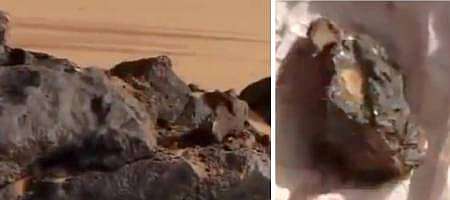

|
| Just few hundred meters southwest
of the location a mixed breccia contains carbonaceous material.
The mineralogical study indicates that it consists of
diamond and graphite with other phases.
The detection of diamond from the area in the form of relatively large
mass (30 grams) bears definite insights on the impact event on the area. |
8.
Crater
Zerzura
Probably a second detected
Kimberlite pipe
|
Cigolini & Di Martino --
PP-presentation (2013)
Here a spectacular find of a breccia from a crater-like structure
is presented, in which probably a swarm
of micro-diamonds can be seen.
Unfortunately, apart from the identified location of the find by me
(25�16'46 "/ 25�10'05") there are no
further comments. The crater is to find in the central wadi of the
Zerzura Plateau, which is located west of the Silica strewnfield.
The crater is nearly round and in no case a depression caused by water
erosion. In the crater's center there is at least one round hole with
a plug of the breccias.
The breccia in the crater may be a kimberlite pipe. Many micro-diamonds
seem to be present ("white sugar"), but are difficult to recognize
in the photos. |
Romano Serra, University of Bologna, has sent me some
new revealing photos from the crater and the breccia, included thin sections.
|
|
|
9. Chunk with diamonds from the Gilf Kebir Crater Field (GKCF)
Roland Keller from Basel (Switzerland) wrote to me on March
03, 2020: �In 2010, about 50 km eastern of Gilf Kebir, I found fist-sized
chunk of kimberlite. The chunk was dotted with diamonds. I had my tester with
me and it responded diamond. I noted: Bedrock gray with 50% inclusions. 2x2
mm large octahedra diamonds, color gray
to slightly yellowish. Density: An octahedron every 5 mm.�
|





